Related Research Articles
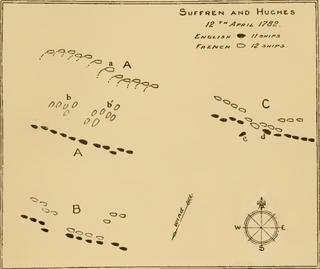
The Battle of Providien was the second in a series of naval battles fought between a British fleet, under Vice-Admiral Sir Edward Hughes, and a French fleet, under the Bailli de Suffren, off the coast of India during the Anglo-French War. The battle was fought on 12 April 1782 off the east coast of Ceylon, near a rocky islet called Providien, south of Trincomalee.

The Battle of Negapatam was the third in a series of battles fought between a British fleet, under Vice-Admiral Sir Edward Hughes, and a French fleet, under the Bailli de Suffren, off the coast of India during the American Revolutionary War. The battle was fought on 6 July 1782. Though the battle was indecisive, Suffren was stopped in his goal by Hughes and withdrew to Cuddalore, while the British remained in control of Negapatam.
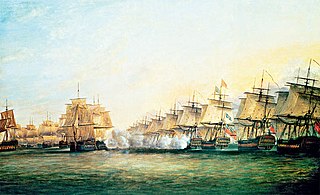
The Battle of Trincomalee was fought between a British fleet under Vice-Admiral Sir Edward Hughes and a French fleet under the Bailli de Suffren off the coast of Trincomalee, then Ceylon, on 3 September 1782. It was the fourth in a series of battles fought between the two fleets off the coast of the Indian subcontinent during the American Revolutionary War.
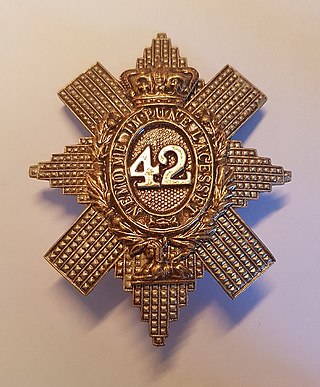
The 42nd Regiment of Foot was a Scottish infantry regiment in the British Army also known as the Black Watch. Originally titled Crawford's Highlanders or the Highland Regiment and numbered 43rd in the line, in 1748, on the disbanding of Oglethorpe's Regiment of Foot, they were renumbered 42nd, and in 1751 formally titled the 42nd (Highland) Regiment of Foot. The 42nd Regiment was one of the first three Highland Regiments to fight in North America. The unit was honoured with the name Royal Highland Regiment in 1758. Its informal name Black Watch became official in 1861. In 1881, the regiment was amalgamated with 73rd (Perthshire) Regiment of Foot under the Childers Reforms into The Royal Highland Regiment , being officially redesignated The Black Watch in 1931. In 2006, the Black Watch became part of the Royal Regiment of Scotland.

The 72nd Highlanders was a British Army Highland Infantry Regiment of the Line. Raised in 1778, it was originally numbered 78th, before being redesignated the 72nd in 1786. Under the Childers Reforms it amalgamated with the 78th (Highlanders) Regiment to form the 1st Battalion of the Seaforth Highlanders in 1881.

The 78th (Highlanders) Regiment of Foot was a Highland Infantry Regiment of the Line, raised in 1793. Under the Childers Reforms it amalgamated with 72nd Regiment, Duke of Albany's Own Highlanders to form the Seaforth Highlanders in 1881.
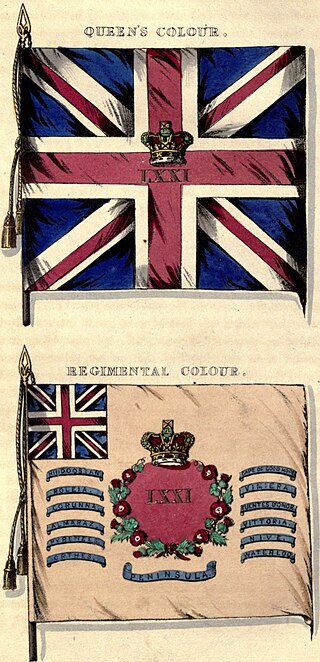
The 71st Regiment of Foot was a Highland regiment in the British Army, raised as the 73rd (Highland) Regiment of Foot in 1777. Under the Childers Reforms it amalgamated with the 74th (Highland) Regiment of Foot to become the 1st Battalion, Highland Light Infantry in 1881.

The 86th Regiment of Foot was an infantry regiment of the British Army, raised in 1793. Under the Childers Reforms it amalgamated with the 83rd Regiment of Foot to form the Royal Irish Rifles in 1881.
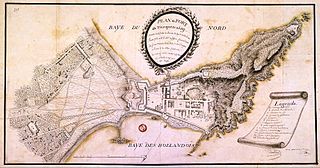
The Capture of Trincomalee on 11 January 1782 was the second major engagement between Great Britain and the Dutch East India Company in the East Indies after the outbreak of the Fourth Anglo-Dutch War. After capturing Negapatam, the major Dutch outpost in India, a British force assaulted the Dutch-controlled port of Trincomalee on the eastern coast of Ceylon, and successfully stormed Fort Fredrick and Fort Ostenburg to gain control of the city and the port. In gaining control of the port, they also captured the vessels there at the time.
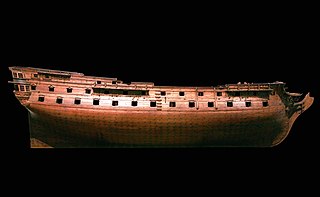
The Vengeur was a 64-gun ship of the line of the French Navy designed by Antoine Groignard. She saw action with Bailli de Suffren during the American War of Independence.

Admiral comte Pierre André de Suffren de Saint Tropez, bailli de Suffren, Château de Saint-Cannat) was a French Navy officer and admiral. Beginning his career during the War of the Austrian Succession, he fought in the Seven Years' War, where he was taken prisoner at the Battle of Lagos. Promoted to captain in 1772, he was one of the aids of Admiral d'Estaing during the Naval battles of the American Revolutionary War, notably taking part in the Siege of Savannah.
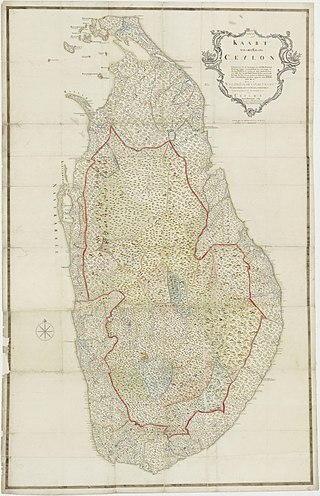
The Invasion of Ceylon was a military campaign fought as a series of amphibious operations between the summer of 1795 and spring of 1796 between the garrison of the Batavian colonies on the Indian Ocean island of Ceylon and a British invasion force sent from British India. The Dutch Republic had been a British ally during the French Revolutionary Wars, but was overrun by the French Republic in the winter of 1794 and reformed into the client state of the Batavian Republic. The British government, working with the exiled Stadtholder William of Orange, ordered the seizure of Batavian assets including colonies of the former Dutch Empire. Among the first territories to be attacked were those on the coast of the island of Ceylon, with operations initially focused on the trading port at Trincomalee.
Pierre Servan René Bouvet de Maisonneuve was a French naval officer. He served in several notable battles, notably the action of 17 June 1778, and the battles conducted by Suffren in the Indian Ocean. He was wounded at the Battle of Porto Praya. He was the father of Pierre François Étienne Bouvet de Maisonneuve.
Fort MacDowall was located in Matale. It was a fortified outpost during the Kandyan Wars, named after Major General Hay MacDowall, the 6th Commander of British Troops in Ceylon. The fort was one of the few inland forts constructed by the British and was completed in 1803.
Lieutenant-General Day Hort MacDowall DL was a British Army officer who served as colonel of the 3rd Regiment of Foot.
John Evans, 5th Baron Carbery, known until 1804 as Hon. John Evans, was an Irish peer.
Fine was a Sybille class 32-gun, copper-hulled, frigate of the French Navy.
The action of 12 August 1782 was a minor single-ship action that opposed the French 32-gun frigate Bellone to the British 28-gun HMS Coventry in the run-up to the Battle of Trincomalee. Although both ships were frigates, Bellone belonged to the Iphigénie class and was a comparatively large frigate for her time, carrying a battery of 18-pounder long guns, while Coventry was a sixth-rate armed only with 9-pounder long guns. Furthermore, Bellone had the advantage of the wind. The nominal crew of Coventry was about tho thirds of that of Bellone, but in the occasion it was reinforced by the troops she was carrying. In spite of these overwhelming odds, Coventry managed to inflict heavy casualties on Bellone, and most decisively to shoot most of the senior staff. The resulting confusion on Bellone allowed Coventry to escape to Madras.
Lézard was a 16-gun Cerf-class cutter of the French Navy. She was built in 1781, and took part in the Indian theatre of the Anglo-French War. She was captured by the 74-gun HMS Sultan in October 1782 at Trinquebar, and later returned to France.
Naïade was a 20-gun Coquette-class corvette. She took part in the Indian theatre of the Anglo-French War with the squadron under Suffren. The British Royal Navy captured her in 1783 but never commissioned her; it sold her in 1784.
References
- Cunat, Charles (1852). Histoire du Bailli de Suffren. Rennes: A. Marteville et Lefas. p. 447.
- Hennequin, Joseph François Gabriel (1835). Biographie maritime ou notices historiques sur la vie et les campagnes des marins célèbres français et étrangers (in French). Vol. 2. Paris: Regnault éditeur. pp. 289–332.